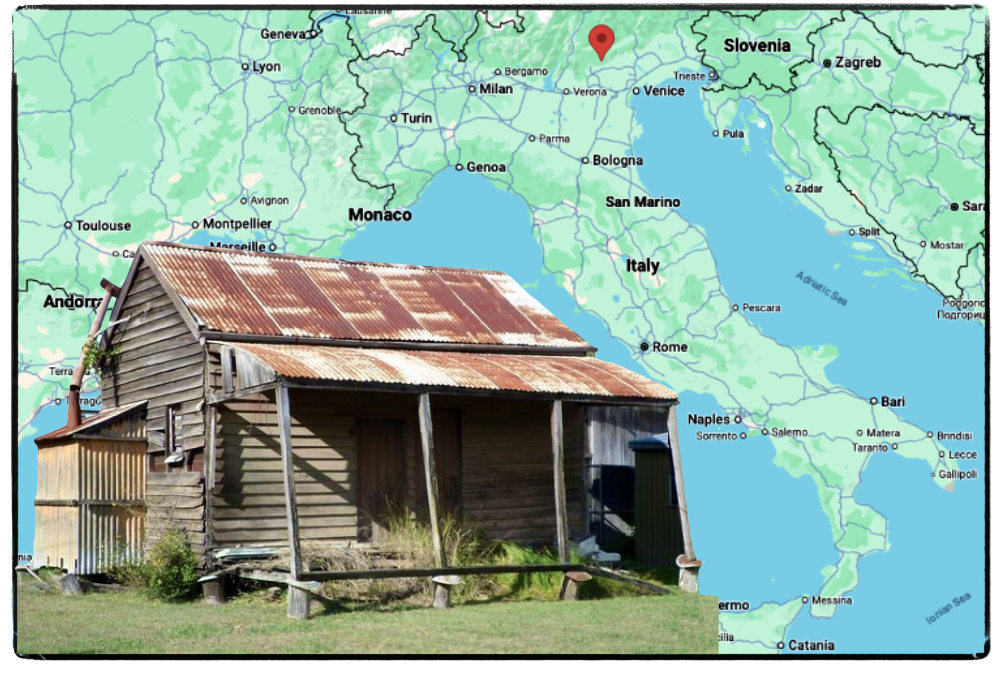
Rosewood History
Rosewood’s Comunità Italiana (Italian Community)
In amongst the Irish and English families who predominantly resided in Rosewood town, there were a couple of Welsh families, Greek families and some Italian families, not forgetting Mr. Pedrazzini, who was Swiss (not Italian like many thought).
The Italian folk were le famiglie di Sbeghen, Gabardo, Maculan, Zandegiacomo (Zande) and Santacaterina.
What made them leave Italy? There were a couple of reasons which could account for it.
Firstly, the wavering economic development of post-war Italy reduced many to poverty (inflation, mass unemployment, food shortages, debt etc.). Then there were the severe internal tensions within the country with the rise of fascism.
When the Allies were victorious in the Great War, Italy found itself on the winning side of democracy against the losing autocratic States. There was a period of political transition and chaos while the government unsuccessfully attempted to introduce a system of democracy. When Benito Mussolini came to power in October 1922, Italy became the first European State in the interwar period to come under the rule of a Fascist government. During the first 5 years of Mussolini’s rule, at least 1,500,000 people left Italy.
Those loyal to Mussolini formed a voluntary militia. They supported the landowners and opposed socialism (the peasants’ and country labourers’ unions). Known as Blackshirts or squadristi, they used violence and intimidation against socialists and liberals and carried out land occupations in their bid for compliance with the fascist doctrine. Mussolini’s aim was to become a one-party State and to integrate Fascism into all aspects of life.
Three Italian men who were destined to become Rosewood residents arrived in Australia in 1925 and others came soon after. You’ll see how the families intertwined as we go along. They would have been parishioners of St Brigid’s Church and their children would have attended the local schools. These new residents gave those institutions an opportunity to learn about and embrace the influence of a different culture, in turn helping their new friends to feel welcomed and part of the community.
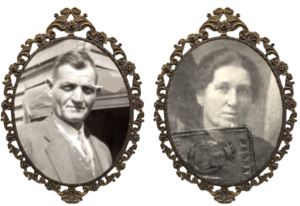 The first to arrive in Australia was Cesare SBEGHEN.
The first to arrive in Australia was Cesare SBEGHEN.
Birth: 13th March 1884, Venice, Vicenza, Italy
Occupation: Farm Labourer (1929); Labourer (1943, 1963)
Residence: Piovene, Vicenza, Veneto, Italy
Immigration: 12th January 1925, arrived Fremantle per Moncalieri from Genoa.
Residence: 1928, Cordalba via Childers, Queensland
Residence: 1930, Rosewood, Queensland
Residence: 1943 1962, Albert Street, Rosewood
Death: 27th October 1962, Ipswich, Queensland
Burial: Ipswich General Cemetery
Religion: Roman Catholic (3A, Grave number B6181)
Father: Pietro SBEGHEN
Mother: Pierina GRIGOLETTO
Marriage: 22 March 1903, Piovene, Vicenza, Veneto, Italy
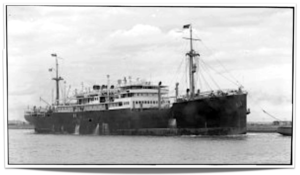 Spouse: Emilia TARGON
Spouse: Emilia TARGON
Birth: 3rd October 1883, Grancona, Vicenza, Veneto, Italy
Immigration: 21st June 1931, per Viminale to Brisbane from Genoa (pictured at right)
Death: 28th July 1959, St Andrews Hospital, Ipswich
Burial: Ipswich General Cemetery
Father: Alberto TARGON
Mother: Angela GALEOTTO
Children: 4
Angelina Giuseppina SBEGHEN (1909-1963) = Della Morte Michele ZANDEGIACOMO
Maria SBEGHEN (1911-1947) = Pio MACULAN
Giuseppe (Joseph) SBEGHEN (195-1979) = Mabel Ellen DILGER
Pietro (Peter) SBEGHEN (1918-2002) = Bice (Betty) GABARDO
Cesare Sbeghen served in the Italian Army in WW1. He and Emilia had to abandon their house because of the war. Emilia and the children went to live with their Aunt at Via dei Cairoli in Vicenza. In the post war years Cesare was against the Fascist system of law and order and the heavy handed, brutal tactics used by the squadristi. Cesare left his wife and children back in Piovene in Northern Italy and travelled to Australia alone to set up a better life for his family.
The Moncalieri arrived at Fremantle, Western Australia. All 208 Italians on board were from Northern Italy. Immigration records indicate that Cesare had scar on right side of chin and could speak and read English well, but was a poor writer. The Italian Government compelled all immigrants to carry larger sums (at least £40) in order to provide against the possibility of their becoming stranded in a foreign country.
The following day the ship steamed on to Melbourne, then on to Sydney, arriving on 22nd January. Cesare spent two weeks in Sydney before heading for Brisbane. He found work in the Isis district at Cordalba near Childers and stayed there for 4 years 10½ months before coming to Rosewood. There he found employment with Mr. James O’Shea at Dale’s quarry.
In February 1830, Cesare applied for his wife Emilia and his children to immigrate.
In the interim, in early March 1930, Cesare met with a painful accident at work. The stone cracker he was using broke, and a portion of it flew up hitting him in the eye. Dr. Wallace treated him for a couple of weeks before he was admitted to St. Mary’s Hospital in Ipswich. His eye was X-rayed and it was feared that his eye might have to be removed. He was transferred to a private hospital in Brisbane for an operation.
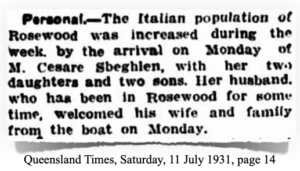 Finally, after such a long wait, Emilia and their two daughters and two sons arrived in June 1931. Cesare was there waiting on the Brisbane wharf when the ship docked.
Finally, after such a long wait, Emilia and their two daughters and two sons arrived in June 1931. Cesare was there waiting on the Brisbane wharf when the ship docked.
There had been a small delay in getting to Brisbane. After leaving Fremantle, the passengers of the Viminale had the unique experience of disembarking at Duke and Orr’s dry dock in Melbourne. The vessel had to be docked to undergo an examination to ascertain the extent of the damage done to her propellers after she struck a submerged object in the Great Australian Bight. Being 468 feet long and 57 feet wide, it was one of the largest vessels that had ever been dry docked at Melbourne.
Emilia and her daughters were the first Italian women to settle in Rosewood. Up until then, the small Italian community in Rosewood had been all men who had been industriously engaged, mostly in mining and road-work.
On 19th October 1931, before William Simpson, Police Magistrate at Rosewood, Cesare swore an Oath of Allegiance to His Majesty King George the Fifth and became a British Subject. When asked about his conduct during the war he said, ‘In Italy while the war was on, I fought with the Italian Troops”. Perhaps that is where he received the scar on his chin?
Youngest son, Pietro “Peter” Sbeghen was a miner at Rosewood Colliery (from about 1935). He paid the required £5 Statutory Fee and was naturalised on 4th February 1944, before Thomas Hickey, Clerk of Petty Sessions at Rosewood. He was living at Toowoomba Road at the time. Ernest Joynson Senior & Junior (Rosewood Colliery) John Ward (J.P. and C.P.S. Laidley) gave him references. He could read and write and speak English fluently.
Peter married Bice “Betty” Gabardo on 26th December 1943. Betty and Peter made their home in Albert Street. Peter died in Rosewood in 2002 and Betty in 2016 (late of St Mary’s Hostel, Raceview, formerly of Rosewood). They are interred at Warrill Park Lawn Cemetery. (Plot: 3/3 – 21/AU)
WEDDINGS. Sbeghen-Gabardo
With Nuptial Mass, the wedding was solemnised in St. Brigid’s Church, Rosewood on December 26, of Miss Betty Gabardo, youngest daughter of Mr. and Mrs. A. Gabardo Rosewood, and Mr. Peter Sbeghen, second son of Mr. and Mrs. C. Sbeghen, Rosewood. Rev. Father O’Rourke (Parish Priest) officiated. The bride, who was given away by her father, wore a frock of crepe satin. Her embroidered tulle veil (lent by Mrs. R. J. Skinner) was held in position at the top of the head with a halo of orange blossoms. The bridal bouquet was delicately tinged with pink. Mrs. J. Sbeghen, who attended as matron-of honour, wore a long blue tiffin frock, a large blue picture hat. and carried a bouquet of roses and gerberas, tied with ribbon. Mr. Joseph Sbeghen was the best man. Miss Molly Potts presided at the organ. Mrs. R. J. Skinner sang during the Mass, and while the register was being signed. The bride’s mother wore a frock of wine shaded reversible satin, with a posy of frangipani. A frock of brown crepe romaine was worn by the bridegroom’s mother, with a red rose. The reception was held at the home of the bride’s parents. The wedding cake was made by Mrs. S. Harding , and the bouquets by Mrs. J. Wanka. Mr. and Mrs. Peter Sbeghen’s home will be in Rosewood. (1)
![]()
The second of the Italian men to arrive in Queensland was Angelo GABARDO.
Birth: 9th June 1885, Valstagna, Vicenza, Veneto, Italy
Occupation: Farm Labourer; Cane cutter: Coal Miner
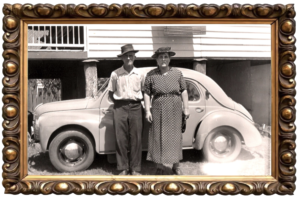 Immigration: 31st March 1925, per S. S. Carignano to Melbourne from Genoa
Immigration: 31st March 1925, per S. S. Carignano to Melbourne from Genoa
Residence: 3 Albert Street, Rosewood
Death: 1st July 1963, Queensland
Burial: Ipswich General Cemetery
Religion: Roman Catholic
Father: Antonio GABARDO
Mother: Madelena ZANNINI
Marriage: 9th May 1909, Chiesa di Sant’Antonio Abate, Valstagna, Italy
Spouse: Corona GHENO
Birth: 24th June 1886, Valstagna, Vicenza, Veneto, Italy
Immigration: 12th March 1939, per Viminale to Brisbane from Genoa
Death: 12th August 1967, Queensland
Burial: Ipswich General Cemetery
Religion: Roman Catholic
Father: Matteo GHENO
Mother: Vittoro STEFANI
Children: 3
Rina GABRADO (1913- )
Narciso GABARDO (1912-1979) = Gina Madalena MARTIN
Bice or Beatrice “Betty” GABARDO (1922-2016) = Pietro “Peter” SBEGHEN
Like Cesare Sbeghen, Angelo travelled ahead of his wife and children to find a stable footing for his family in a new country. The Italian steamer Carignano transported 245 Italians, most destined for the cane fields, and approximately 2,000 tons of general cargo. The cargo included motor cars, hats, sulphur, oils, cheese, almonds. From India coir mats, fibre and ginger were carried for southern ports. Brisbane’s quota of that cargo was 164 tons, made up of hats, fibre, motor cars and coir mats.
Captain Govanni Rivarola said, “Italy with its population of 50,000,000 in full up.” He anticipated that about 8,000 Italians would come to Australia yearly, but up to 300,000 emigrants of the agricultural class were ready to come.
Valstagna, the home town of the Gabardos, is in Northern Italy and runs along the right side of the Brenta River between high rocky walls. The Brenta Valley lies on the southern rim of the Alps.Tobacco growing was the main economic resource for the valley inhabitants. During World War 1, Valstagna became a strategic point, because the Austro-Hungarian Army saw it as an entrance place to get to the Venetian plain. Therefore, the Italian troops coming from or going to the front line, were living in all of the homes of the village residents. The villagers were forced to work constructing roads and other infrastructures before being completely evacuated in 1917.
After his arrival in Australia, Angelo spent 6 months in Melbourne before travelling to Queensland. Immigration records state that he had a bayonet mark extending from the point of his nose across top lip to right side of cheek. He found 3 month’s work as a farm labourer at Mallee Creek near Bundaberg and another 6 month’s work on a sugar cane plantation “Beaconsfield”. He was employed by Richard Webb and William Edmonds Cocking on their plantation at Lynwood near Childers. (What is that old saying..six degrees of separation? The idea that all people are six or fewer connections away from each other? His employers, Webb and Cocking are on my family tree.)
Angelo came to Rosewood about November 1926, and was employed at Normanton Colliery. He found a house to rent on the corner of Albert Street and Royal George Lane. His son, Narciso, arrived in Australia on the 15th July 1928, per the Principe Di Udine to Brisbane from Genoa, 3 years after Angelo had landed. He joined his father at Albert Street.
Angelo’s wife Corona and their daughter Bice, aka Betty, immigrated 14 years after Angelo in 1939 aboard the S S Viminale. It is thought that Corona didn’t want to leave her home until her parents were deceased. The Italians and Greeks who travelled in the Viminale were bound for farming and sugar districts in the North, including Mullet Creek, Sarina, Amiens, Ingham, South Johnstone, Mourilyan, Thangool, Jambin, Silkwood, Bundaberg, Biloela, Innisfail, Rosewood, Halifax, and Tolga. There were 19 Immigrants in the Viminale aged under 21, their ages ranging from 7 to 19.
In 1939 Angelo applied to be naturalised. Despite references from John Patrick Roache, William Norman Ruhno and Henry Alexander Mark Grant, he was denied for not having adequate knowledge of the English language. Ultimately, in a simple but impressive ceremony at the Ipswich Court House on Monday morning 27th July 1950, Angelo finally took the oath of allegiance to become an Australian citizen. The ceremony was conducted by Mr. C. Innes, Acting S. M.. With an Australian flag in the background, Angelo Gabardo of Rosewood, swore to be faithful to King George VI, observe the laws of Australia and fulfil his duties as an Australian citizen. Albert Edward Yarrow, Leslie Harold North and John Patrick Roache were his referees.
Their eldest daughter Rina, born 20th September 1913, was married in Italy before her parents and siblings left and she stayed in Italy. Corona went back to Italy visit Rina per the Roma on 19th May 1958, and arrived back at Brisbane on 23rd November 1958 per Sydney.
It was because of this trip that Corona found out that she wan’t naturalised. She thought she had been included under Angelo’s certificate. Even though she had successfully applied for her old age pension and was registered on the electoral roll, she had to apply and pay a fee of 10 shillings to become an Australian citizen. The ceremony was held on the 26th January 1960. Lloyd William Ruhno (Business Manager), Ellen Leone Jones (Clerk) and Thomas Henry Estling Palmer (Solicitor, Ipswich) were her referees.
Angelo worked at Normanton Colliery for almost 20 years until he was injured by a fall of coal and retired. Both Angelo and Corona could not read English, but they had an adequate knowledge of it and were able to converse well enough (Angelo more so) to become well liked and respected members of the community.
Angelo and Corona Gabardo lived in a cottage at 3 Albert Street (cnr Albert Street and Royal George Lane) from around 1926 until they died. The photos below show what was left of their home in 2019.
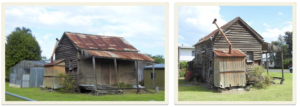
Greg Brown, who grew up at 45 Railway Street, recounted the following: The house on corner of Albert St and Royal George Lane was lived in by Mr Angelo Gabardo, an old Italian. He loved to walk down Railway St with his shotgun across his back and would shoot wild ducks and pigeons down by the railway bridge.
Settlers’ cottages like the Gabardo home would have been commonplace in the early days of the Rosewood district. This block of land on which the cottage stood was situated was the top part of Lot 21 of John William Vance’s original selection, which ran from the corner of Royal George Lane and Albert Street down to Railway Street (on the left hand side).
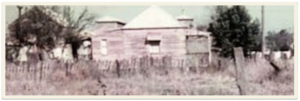
Originally the home was comprised of two buildings connected by a walkway (pictured above). After the Gabardos died one of the buildings was destroyed by a fire. That was the front building which housed three bedrooms, the dining room and bathroom. The detached kitchen survived the fire. It is visible behind the trees at the back of the house.
The features of this house were typical of a Colonial style house built between 1859 and 1901. A steeply-pitched, corrugated iron, gable roof with minimal eaves. A stepped verandah with convex roof attached to the house wall below the main gutter and decorative verandah ends. Posts with little or no decoration supported the verandah roof and if it was low-set, no balustrade was needed (1850s to early 60s). Elevated on timber stumps and chamfer boards 8 inches (20cm) or more wide.
A distinguishing feature of a house that was built before 1900, and one that was built after, was the stepped verandah (the roof was fixed to the wall below the tin roof over the core of the building). Other features of a Colonial house are a brick chimney and a kitchen detached or under a skillion roof. Simple rectangular posts were used from the 1850s until early 1880s.
Who built the house? In 1882 George Whitney from Mount Walker bought Lot 21 from John Vance and built a store on the corner of Albert Street and Railway Street, the shop fronting Railway Street. It is probable that he also built the cottage to live in. In early 1884 Whitney sold his business to Albert Vance and left town. By 1888 Johann Ludwig Frederich had acquired the land and business. On the 1st December 1907, Frederick William Ruhno bought the property from John Frederich. When Euphemia Ruhno died in 1944, her children Norman and Elise inherited the block. In 1947 it was transferred to William Norman Ruhno soley and then subdivided in October 1956.

The Knack family lived next door at 10 Royal George Lane. They bought the property and used it for storage. Herbert (Timber Cutter) and Jessie Agnes Knack built the sheds and the bird cages you see in the photo. Herb showed birds and poultry at the shows. The little building became known locally as “Knack’s house” and become an iconic feature in the town.
I was fortunate enough to be able to sit on my verandah and look at the remains of the old cottage until it was demolished at 6 a.m. one Saturday morning in August 2020. It had great character, and in my opinion, some historic value. To see it there one minute and gone the next was thought provoking to say the least. It has been missed.
About No 10. The Edgeworth family built the house at 10 Royal George Lane in November-December 1941. Francis Jack (Bob), a Bootmaker & Iris Jean Edgeworth moved into their new home after they were married on 13th December.
Back to the Gabardos….
Narciso Gabardo was a miner at the Rosewood Colliery. He was naturalised 23rd April 1937 before moving to North Queensland. He selected Portion 191 (171 acres) in the parish of Johnston, at the Innisfail Land Court on 4th November 1943, and became a dairyman.
 Narciso served in the AMF (QX31521) in Papua New Guinea in WW2, including in the Bougainville Campaign and also in the Solomon Islands.
Narciso served in the AMF (QX31521) in Papua New Guinea in WW2, including in the Bougainville Campaign and also in the Solomon Islands.
In 1947 he fractured his nose when a crank handle struck it. He had lived at East Palmerston for 12 years before returning to Rosewood, where he got a job in at the colliery and boarded with his parents.
He married Gina Madalena MARTIN 23rd April 1954. Gina was born 7th February 1922 at Prato Carnico, Belluno, Italy and immigrated on 30th June 1949 per MV Surriento to Brisbane via Fremantle. Gina went to live with her sister Gemma Maria Gonano at Birkdale. Gemma had been in Australia for 11 years and was the widow of Giovanni Giacomo Ganano, a small crop farmer.
Gina was naturalised on 26th January 1960 at the Rosewood Courthouse by Henry William Hayes, Chairman of the Moreton Shire Council. She gave her occupation as Casalinga (housewife). Lloyd William Ruhno, John Heenan (Publican) and Thomas Henry Estling Palmer (Solicitor, Ipswich) gave her character references. They had a son, Ronald Joseph Sbeghen.
Narciso and Gina Gabardo were living at No 8 Royal George Lane from the late 1950’s into the 60’s before moving to Kynance Street, Leichhardt. Narciso died in 1979. Gina had been living at the C.W.A. Hostel in Ipswich when she died in 1997. They are buried at Warrill Park Lawn Cemetery. (Melia Avenue, Section 1, Row 10)
Note: In 1950, Narciso applied for one of his cousins Sidi Mariano PONTAROLLO to immigrate. Sidi’s mother Maria (née Gehno) was Corona’s sister. Sidi arrived in October 1950 per Sebastiano Caboto. He found employment in the mines in Ipswich and lived at Railway Street, Booval. Sidi married Elvira née Pitruzzello from Sicily and went to live at 15 Clifton Street, Booval. They were neighbours of my grandparents for many years. (Six degrees of separation?) Sidi gave up mining and became a textile worker like Elvira at one of the Ipswich mills.
![]()
The third Italian man to arrive in Australia in 1925, and the first man to come to Rosewood was Della Morte Michele ZANDEGIACOMO.
AKA: Michele Arcangelo ZANDEGIACOMO
Birth: 27th January 1903, Auronzo, Di Belluno, Veneto, Italy
Occupation: Labourer (1932, 1949) Miner (1930, 1958, 1963)
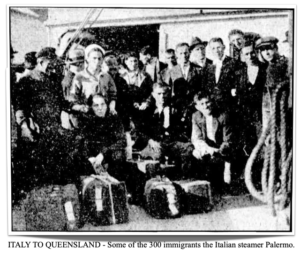 Immigration: 21st April 1925, per S S Palermo from Genoa to Fremantle, then Brisbane.
Immigration: 21st April 1925, per S S Palermo from Genoa to Fremantle, then Brisbane.
Residence: 1929, Mill Street, Rosewood
Residence: 1930, John Street, Rosewood
Residence: 1932, 1949, Rosewood
Residence: 1958, 1963, 13 Fox St, Booval
Death: 30th July 1972, Rosewood, Queensland aged 69 years
Burial: Ipswich General Cemetery (Roman Catholic 3A, Row 17, Grave 34)
Father: Bortolo ZANDEGIACOMO
Mother: Filomena PAOLINO
Marriage: 10th October 1931, St. Brigid’s Church, Rosewood
Spouse: Angelina Giuseppina SBEGHEN
Occupation: Housekeeper (1931)
Birth: 12th February 1909, Piovene, Veneto, Italy
Immigration: 21st June 1931, per Viminale to Brisbane from Genoa
Death: 15th August 1963, Ipswich, Queensland aged 54 years
Burial: Ipswich General Cemetery (Roman Catholic 3A, Row 3, Grave 33)
Father: Cesare SBEGHEN
Mother: Emilia TARGON
Children: 4 (not in order)
Richard ZANDE
Leo Selwyn ZANDE
Male ZANDE
Female ZANDE
Michele took the name Michele Angelo ZANDE when he came to this country. He spent a year in Bundaberg before coming to Rosewood. His Certificate of Naturalisation was granted at Rosewood before Acting Magistrate Johnstone Smith on 24th November 1930. His referees were William Ruhno (Merchant), Frank Gunthorpe (Mine Manager) and Hugh Tighe (Sergeant of Police).
Michele had been employed at Westvale Colliery by Frank Gunthorpe since June 1926. He was Deputy at United No 8 mine in January 1953 when he was struck by a power borer, injuring a muscle in his right forearm. He received treatment from the Rosewood Ambulance.
WEDDING. Zandegiacomo-Sbeghen.
Unusual interest was attracted to the wedding in St. Brigid’s Church on Saturday morning last of two members of the Italian community in Rosewood. The bridegroom was Micheli Arcangelo Zandegiacomo and the bride was Miss Angelina Sbeghen. who recently arrived from Italy with her mother, sister and brothers to join their father, Cesare Sbeghen, who had been here for some time. Rev. Father O’Rourke celebrated the Nuptial Mass and performed the marriage ceremony in Italian. Miss Molly Potts, A.L.C.M., played the wedding and bridal marches. Sweetly pretty was the bride as she entered the church on her father’s arm in beaute. Her only adornment was a fine gold necklet with a small cross. An embroidered tulle veil, which fell to form a train, was fitted close to the head with garlands of orange beads and satin ribbon. She carried a sheaf of arum lilies and roses tied with satin ribbons (the gift of the Sisters of Mercy). Miss Marie Sbeghen attended her sister and was gowned in cream crepe de Chine with touches of pink embroidery and a hat of crin straw finished with flat pink posies. Mr. Angelo Corte was best man. After the ceremony the “festa” was held at the home of the bride’s parents, only immediate friends being present. The three-tier wedding cake was made by Mrs. Brown. Mrs. Zandegiacomo, on leaving later in the day for the seaside, wore a dainty summer frock of white hail-spot voile, and a hat of russet straw with flat flowers. They will reside at North Rosewood. (2)
![]()
The fourth Italian man to arrived in Australia in 1926 was Morte Antonio Osvaldo ZANDEGIACOMO, Michele’s older brother.
 Antonio was born 29th May 1901 at Auronzo, Di Belluno, Veneto, Italy and immigrated to Sydney aged 25. He landed Friday, 18th June 1926, per Citta di Genova at No 3 Wharf, Walsh Bay, Sydney. Antonio immediately caught a train to Sydney and then came directly to Rosewood where he found work at Westvale Colliery (where he remained) as a Coal Miner.
Antonio was born 29th May 1901 at Auronzo, Di Belluno, Veneto, Italy and immigrated to Sydney aged 25. He landed Friday, 18th June 1926, per Citta di Genova at No 3 Wharf, Walsh Bay, Sydney. Antonio immediately caught a train to Sydney and then came directly to Rosewood where he found work at Westvale Colliery (where he remained) as a Coal Miner.
His Naturalisation Certificate was granted 4th February 1935.
In March 1949 he rented a house in John Street from Mr. W. Domrow for 6/- per week and was earning £17 per fortnight at the mine.
Antonio applied to bring out Miss Constanza Pontarollo (whom he intended to marry) from Valstagna in October 1948. She did not want to marry by proxy while she was still in Italy. Antonio provided letters written in Italian from Constanza to him as proof of their betrothal. If approved, she was allowed to stay in the country for 3 months in which time she and Antonio had to marry. Antonio was required to enter into an assurance bond of £100 with the government and Lloyd William Ruhno signed that Antonio was respectable and honest and was good for it. Constanza arrived at Sydney via Fremantle per Ugolino Vivaldi on 31st August 1949 but seems to have vanished. If so, Antonio would have lost his bond money.
In 1948 Antonio also applied, and paid £40, for his sister Flora Maria Della Morte Zandegiacomo (born 1897) to join them in Australia. Flora landed at Fremantle per Ugolino Vivaldi on 10 June 1951. She went to live with Antonio at 10 William Street.
Antonio died 10th March 1963 and Flora died 30th December 1989. They are buried together in the Ipswich General Cemetery (Roman Catholic 3A, Row 3)
![]()
The fifth Italian man to come to Rosewood was Pio MACULAN.
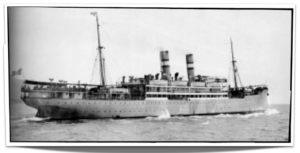 Occupation: Bricklayer (1927); Farm Labourer (1933); (1937)
Occupation: Bricklayer (1927); Farm Labourer (1933); (1937)
Birth: 16th May 1904, Centrale, Lugano, Vicenza, Veneto, Italy
Immigration: 15th September 1927, per Regina D’Italia to Brisbane (pictured at right).
Residence: 1937, employed at Eversly Estate, Kowbi vai Childers
Residence: 1943, Main Street, Childers
Residence: 1949, 1980, 178 Churchill Street, Childers
Death: 27th October 1982, Childers, Queensland aged 78 years
Buried: Ipswich General Cemetery (Roman Catholic 3A, Row 12, Grave 20)
Father: Francesco MACULAN
Mother: Antonia BAGGIO
Marriage: 5th December 1931, St. Brigid’s Church, Rosewood (Witnesses were Arcangelo Zandegiacomo and Angelina Sbeghen)
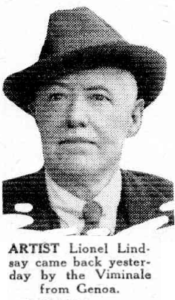 Spouse: Maria SBEGHEN
Spouse: Maria SBEGHEN
Birth: 1st March 1911, Piovene, Vicenza, Veneto, Italy
Occupation: Housekeeper (1930)
Immigration: 21st June 1931, per Viminale to Brisbane from Genoa
Death: 27th October 1947, Brisbane Hospital, Brisbane, Queensland aged 36 years
Buried: Ipswich General Cemetery (Roman Catholic 3A, Row 12, Grave 20)
Father: Cesare SBEGHEN
Mother: Emilia TARGON
Children: 5 (may not be in order)
Francesco MACULAN
Cesarino MACULAN
Emilia MACULAN
Antionetta MACULAN
Female MACULAN
Pio was in the Army in Italy in 1924 and 1925. When he arrived in Queensland he went to his relative in Queensland (Angelo Jantacaterina) who lived in Kolan Street, Bundaberg.
An interesting snippet about Pio’s trip to Australia is that there was someone famous on board the Viminale. Lionel Arthur Lindsay, an Australian artist, renowned for his paintings and etchings was travelling home on the same ship as Pio after visiting Italy.
Pio was working for Mr. James O’Shea in August 1928 when he sustained a compound fracture of the arm. The motor lorry he was cranking back fired. He was taken for treatment at the Ipswich General Hospital. I wonder if it was the same lorry that James O’Shea purchased from the Rosewood Shire Council in late May 1927? The Council sold the truck to James O’Shea conditional upon the acceptance of his tender for road work by the Main Roads Commission.The terms were: price £500, £25 deposit, monthly payments of £50, and the balance, if any, at the termination of the road contract.
In 1931 Pio married Maria Sbeghen.
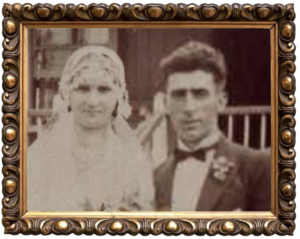 WEDDING. Maculan-Speghen. In St. Brigid’s Church, Rosewood, on Saturday morning a second Italian marriage was celebrated by Rev. Father O’Rourke, P.P., when Mr. Pio Maculan and Miss Maria Speghen, younger daughter of Mr. and Mrs. Caesar Speghen, were married. The bride only recently arrived from Italy with her mother and other members of the family to join their father who had been here for some years. A Nuptial Mass was celebrated by Father O’Rourke and the altars were beautified with red and white roses. The marriage ceremony was solemnised in Italian.The bride, who was escorted to the altar by her father, chose a bridal gown of ivory crepe de Chine made on straight lines with a flared hip frill and worn over a very pale pink silk foundation Her embroidered tulle veil formed a train. A necklet of fine gold set with aquamarines was the gift of the bridegroom, and her bouquet of white roses tied with white satin streamers was the gift of the Sisters of Mercy. Mrs. M. Angelo Zandiacomo (who is a bride of a few weeks) attended her sister as matron of honour, wearing her own wedding gown of ivory satin beaute. Her hat of raisin straw had flat posies brown fancy in apricot shade, and she wore a necklet of apricot beads. Two little girls, Joyce Brown and Dossie Holohan, were train-bearers and wore pink shoulder posies and head-dresses of tulle. They carried bouquets of pink gerberas and carnations. Mr. A. Zandiacomo was best man. Miss Molly Potts, A. L. C.M., played the bridal and wedding marches. After the ceremony the wedding breakfast was held at the home of the bride’s parents. Mr. and Mrs. Maculan left by the morning train for Coolangatta. The bride’s travelling dress was apple green morocain made in bolero effect, the flared skirt having a hip yoke. hat en suite. Mr. and Mrs. Maculan will reside for the present at Rosewood.
WEDDING. Maculan-Speghen. In St. Brigid’s Church, Rosewood, on Saturday morning a second Italian marriage was celebrated by Rev. Father O’Rourke, P.P., when Mr. Pio Maculan and Miss Maria Speghen, younger daughter of Mr. and Mrs. Caesar Speghen, were married. The bride only recently arrived from Italy with her mother and other members of the family to join their father who had been here for some years. A Nuptial Mass was celebrated by Father O’Rourke and the altars were beautified with red and white roses. The marriage ceremony was solemnised in Italian.The bride, who was escorted to the altar by her father, chose a bridal gown of ivory crepe de Chine made on straight lines with a flared hip frill and worn over a very pale pink silk foundation Her embroidered tulle veil formed a train. A necklet of fine gold set with aquamarines was the gift of the bridegroom, and her bouquet of white roses tied with white satin streamers was the gift of the Sisters of Mercy. Mrs. M. Angelo Zandiacomo (who is a bride of a few weeks) attended her sister as matron of honour, wearing her own wedding gown of ivory satin beaute. Her hat of raisin straw had flat posies brown fancy in apricot shade, and she wore a necklet of apricot beads. Two little girls, Joyce Brown and Dossie Holohan, were train-bearers and wore pink shoulder posies and head-dresses of tulle. They carried bouquets of pink gerberas and carnations. Mr. A. Zandiacomo was best man. Miss Molly Potts, A. L. C.M., played the bridal and wedding marches. After the ceremony the wedding breakfast was held at the home of the bride’s parents. Mr. and Mrs. Maculan left by the morning train for Coolangatta. The bride’s travelling dress was apple green morocain made in bolero effect, the flared skirt having a hip yoke. hat en suite. Mr. and Mrs. Maculan will reside for the present at Rosewood.
Pio and Maria Maculan eventually moved to Childers. His Certificate of Naturalisation was granted on 12th February 1934 at Childers. Albert David (Farmer of Kowbi, Isis Line), William Kingston (Storekeeper, Childers) and Benjamin Doby (J.P. Childers) were his referees.
![]()
The sixth man to come to Rosewood was Santo SANTACATERINA.
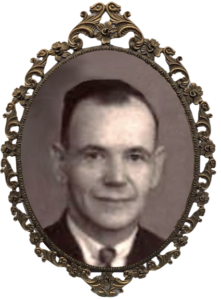 Occupation: Motor Mechanic; Fitter (1949)
Occupation: Motor Mechanic; Fitter (1949)
Birth: 8th April 1901, Thiene, Vicenza, Northern Italy
Immigration: 17th April 1929, arrived at Brisbane per Citta Di Genova
Residence: 1936, Albert Street, Rosewood, Queensland
Residence: 1943, Albert Street, Goodna, Queensland
Residence: 1949, Hut E6, Housing Commission, Wacol
Residence: 1954, Denman Street, One Mile, Queensland
Death: 31st December 1967, Ipswich, Queensland
Burial: Ipswich General Cemetery (Roman Catholic 4A, Row 8, Grave 13)
Father: Massimigliani SANTACATERINA
Mother: Elizabeth MARTINA
Marriage: 23 February 1935, Queensland.
Spouse: Martha Mavis Elizabeth JESBERG
Birth: 9th September 1913, Marburg, Queensland
Death: 28th December 1968, Ipswich, Queensland
Burial: Ipswich General Cemetery (Roman Catholic 4A, Row 8 with Santo)
Father: Jacob JESBERG
Mother: Martha Augusta BULOW
Children: 1 known
Alice Elizabeth SANTACATERINA
Santo came to Rosewood in 1930. He was naturalised at Rosewood on 7th December 1935. Agnes Keane (Householder), William James O’Shea (Cattle Dealer) and John Roache J.P. were his referees.
Santo and Martha stayed in Rosewood for a few years after their marriage before moving to the Ipswich district. While in Rosewood they lived in Albert Street and Santo was working as a Motor Mechanic for contractor James O’Shea. (Perhaps he worked on that same old Council truck as Pio did?)
![]()
© Jane Schy, 2024
Sources:
(1) Queensland Times, Friday 1 January 1943, page 2
(2) Catholic Advocate (Brisbane) Thursday 22 October 1931, page 42
(3) Catholic Advocate (Brisbane), Thursday 24 December 1931, page 50
Copy of original land title John William Vance
Immigration Records (Nation Archives Australia)
Queensland Registry Births Deaths Marriages
Trove (National Library Australia)
Australian Electoral Rolls
Brisbane House Styles – Judy Gale Rechner
Rosewood Then and Now – Susanne Ruijs
Some photos were kindly provided by family members.
